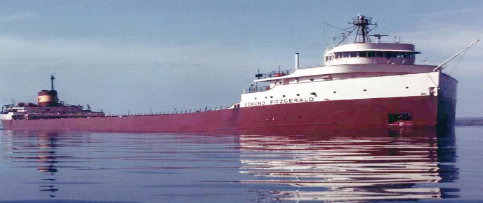SS Edmund Fitzgerald
Launched in September 1958, the Edmund Fitzgerald sailed 17 years transporting taconite (a form of iron ore). Built between 1957 and 1958 at a length of 729 feet, height of 39 feet, and width of 75 feet, the Edmund Fitzgerald was the largest and one of most well known ships in the Great Lakes. The Fitzgerald weighed more than 13,000 tons without cargo.
The SS Edmund Fitzgerald began the ill fated voyage November 9th,1975, with 29 crewmembers, captained by Ernest M. McSorley. Departing Superior Wisconsin, the Fitzgerald planned on sailing through Lake Superior and across Lake Huron to a steel mill near Detroit, MI. A second ship, the Arthur M. Anderson, sailed near the Fitzgerald as a precaution. Throughout the day and night, the storm intensified and made the traveling difficult. At its peak, winds reached 67 mph with gusts up to 80-85 mph and waves swelled to heights of 25 feet. The two ships remained in radio contact until just after 7 p.m. on November 10. The words “We are holding our own, going along like an old shoe.” was the last tansmission received from the Fitzgerald. Shortly there after, the ship went off the radar. Tragically, there were no survivors, all 29 crewmembers went down with the ship.
The Fitzgerald had known problems before the disaster, a list, both radars had been lost, and traveling at lower speeds in heavy seas had allowed water to remain on the deck for longer than usual. However, there is still no definitive explanation for the sinking but several theories are debated.
Rogues Waves- 35 ft rogue waves struck the Arthur M. Anderson at about 6:30 p.m. Cooper, the captain of the Arthur M. Anderson reported that these two waves, possibly followed by a third, continued in the direction of Edmund Fitzgerald and would have struck about the time the Fitzgerald sank.
Shoaling- On November 10th, 1975, it was noted that the Fitzgerald passed dangerously close to a shoal off Caribou Island.
The SS Edmund Fitzgerald began the ill fated voyage November 9th,1975, with 29 crewmembers, captained by Ernest M. McSorley. Departing Superior Wisconsin, the Fitzgerald planned on sailing through Lake Superior and across Lake Huron to a steel mill near Detroit, MI. A second ship, the Arthur M. Anderson, sailed near the Fitzgerald as a precaution. Throughout the day and night, the storm intensified and made the traveling difficult. At its peak, winds reached 67 mph with gusts up to 80-85 mph and waves swelled to heights of 25 feet. The two ships remained in radio contact until just after 7 p.m. on November 10. The words “We are holding our own, going along like an old shoe.” was the last tansmission received from the Fitzgerald. Shortly there after, the ship went off the radar. Tragically, there were no survivors, all 29 crewmembers went down with the ship.
The Fitzgerald had known problems before the disaster, a list, both radars had been lost, and traveling at lower speeds in heavy seas had allowed water to remain on the deck for longer than usual. However, there is still no definitive explanation for the sinking but several theories are debated.
Rogues Waves- 35 ft rogue waves struck the Arthur M. Anderson at about 6:30 p.m. Cooper, the captain of the Arthur M. Anderson reported that these two waves, possibly followed by a third, continued in the direction of Edmund Fitzgerald and would have struck about the time the Fitzgerald sank.
Shoaling- On November 10th, 1975, it was noted that the Fitzgerald passed dangerously close to a shoal off Caribou Island.

